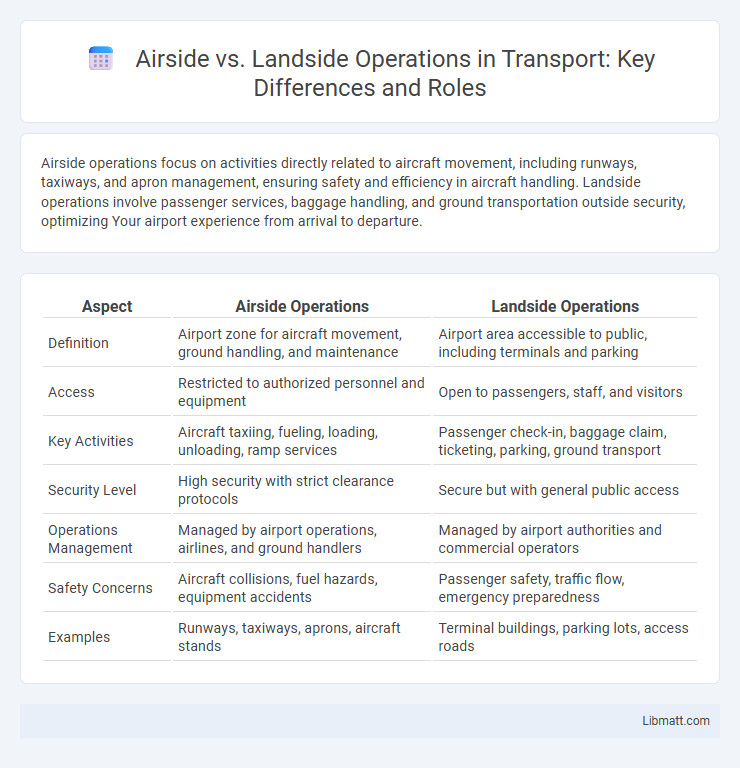Airside operations focus on activities directly related to aircraft movement, including runways, taxiways, and apron management, ensuring safety and efficiency in aircraft handling. Landside operations involve passenger services, baggage handling, and ground transportation outside security, optimizing Your airport experience from arrival to departure.
Table of Comparison
| Aspect | Airside Operations | Landside Operations |
|---|---|---|
| Definition | Airport zone for aircraft movement, ground handling, and maintenance | Airport area accessible to public, including terminals and parking |
| Access | Restricted to authorized personnel and equipment | Open to passengers, staff, and visitors |
| Key Activities | Aircraft taxiing, fueling, loading, unloading, ramp services | Passenger check-in, baggage claim, ticketing, parking, ground transport |
| Security Level | High security with strict clearance protocols | Secure but with general public access |
| Operations Management | Managed by airport operations, airlines, and ground handlers | Managed by airport authorities and commercial operators |
| Safety Concerns | Aircraft collisions, fuel hazards, equipment accidents | Passenger safety, traffic flow, emergency preparedness |
| Examples | Runways, taxiways, aprons, aircraft stands | Terminal buildings, parking lots, access roads |
Introduction to Airside and Landside Operations
Airside operations refer to all activities that occur within the airport's secure perimeter, including aircraft movement, ground handling, and runway maintenance; these operations require strict security protocols and specialized equipment. Landside operations encompass passenger services, parking, terminal facilities, and transportation access outside the security checkpoint, ensuring smooth customer flow and efficient infrastructure management. Understanding the distinct roles of airside and landside operations is crucial for optimizing airport functionality and maintaining safety standards.
Defining Airside Operations
Airside operations encompass all activities conducted within the airport perimeter beyond security checkpoints, including aircraft taxiing, takeoff, landing, and ground handling services. This zone includes runways, taxiways, aprons, and maintenance areas where only authorized personnel and vehicles have access. Effective airside management ensures safety, security, and efficiency in aircraft movement and turnaround times.
Defining Landside Operations
Landside operations encompass all activities and processes that occur outside the airport's security perimeter, including passenger drop-offs, parking management, ticketing, and ground transportation services. These operations ensure smooth access and flow for travelers, ground vehicles, and airport staff before reaching the terminal's secure zones. Efficient management of landside operations directly impacts Your overall airport experience by reducing congestion and enhancing accessibility.
Key Functions of Airside Operations
Airside operations encompass critical functions such as aircraft taxiing, ground handling, refueling, maintenance, and runway management to ensure safe and efficient movement of aircraft. This area is strictly controlled to maintain security and prevent unauthorized access, with coordination between air traffic control and ground services being essential. Your understanding of these key functions helps highlight the complexity and importance of seamless airside management in airport operations.
Key Functions of Landside Operations
Landside operations manage the airport areas accessible to the public, including ticketing, check-in, baggage handling, and passenger transportation. These functions ensure smooth flow and security of passengers before they enter airside zones, optimizing Your airport experience from arrival to boarding. Effective coordination of landside activities directly impacts airport efficiency and passenger satisfaction.
Safety and Security Differences
Airside operations prioritize strict safety protocols due to the presence of aircraft, fueling activities, and moving ground vehicles, requiring authorized access and specialized training for personnel. Landside operations focus more on public security measures, including passenger screening, baggage handling, and crowd control to prevent unauthorized entry and ensure smooth transit. Your awareness of these safety and security distinctions is crucial for complying with airport regulations and maintaining overall operational efficiency.
Regulatory Requirements for Each Zone
Airside operations are governed by stringent regulatory requirements focused on security screening, access control, and compliance with aviation safety standards enforced by authorities such as the FAA or EASA. Landside zones follow regulations related to public safety, traffic management, and environmental standards, overseen by local government and transportation agencies. Both zones require adherence to specialized protocols ensuring safe and efficient movement of passengers, vehicles, and cargo within their respective operational boundaries.
Coordination Between Airside and Landside
Effective coordination between airside and landside operations ensures seamless passenger flow and optimized airport efficiency. Real-time communication systems link ground handling teams with terminal staff to synchronize activities such as aircraft servicing, baggage handling, and passenger check-in. Integrated management platforms facilitate the sharing of operational data, reducing delays and enhancing safety across both zones.
Technological Innovations in Airside and Landside Operations
Technological innovations in airside operations include advanced radar systems, automated ground vehicles, and real-time aircraft tracking, enhancing safety and efficiency in aircraft movement and turnaround times. Landside operations benefit from smart parking solutions, biometric passenger screening, and integrated transportation management systems that streamline passenger flow and reduce congestion. Both areas increasingly leverage IoT devices and AI analytics to optimize resource allocation and improve overall airport operational performance.
Challenges and Best Practices
Airside operations face challenges such as stringent security measures, aircraft movement coordination, and safety compliance, requiring robust communication systems and real-time monitoring technologies. Landside operations must manage passenger flow, baggage handling, and transportation logistics efficiently to prevent congestion and delays. You can optimize airport performance by integrating advanced analytics and cross-departmental collaboration to address these distinct operational challenges effectively.
airside vs landside operations Infographic

 libmatt.com
libmatt.com